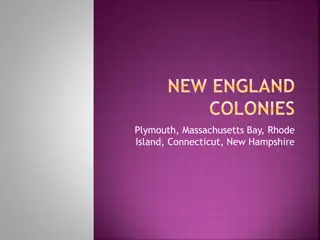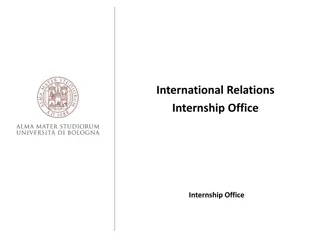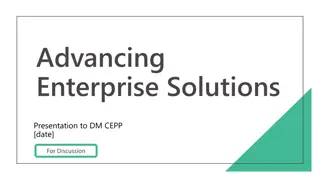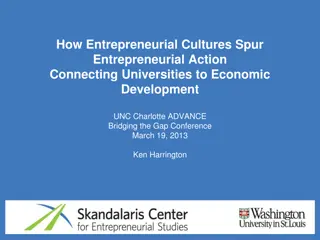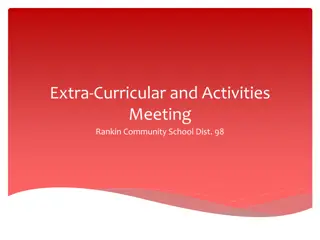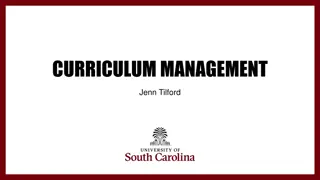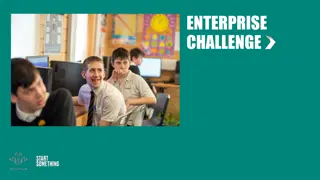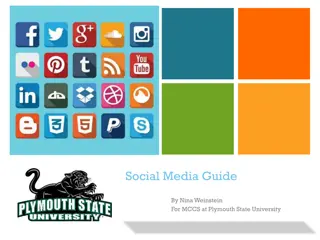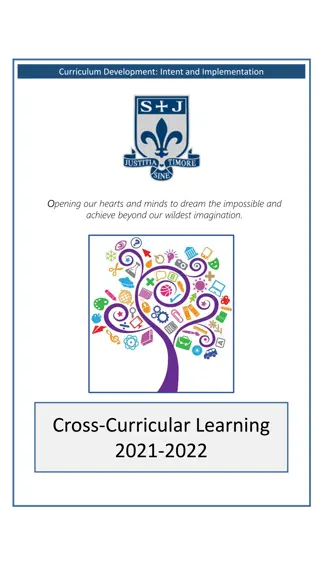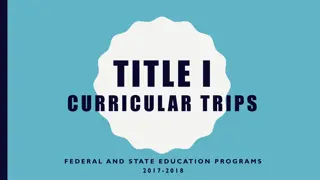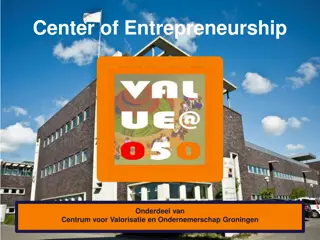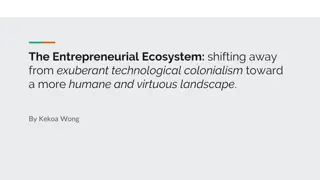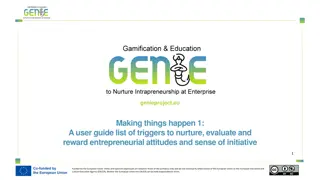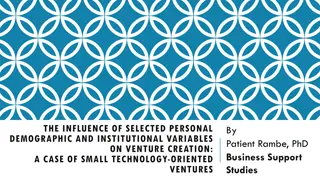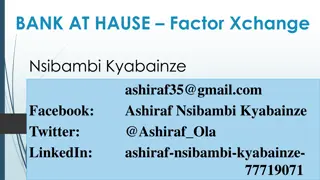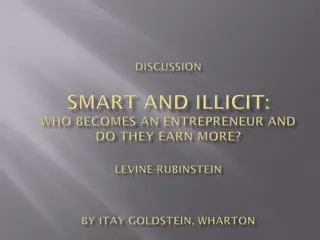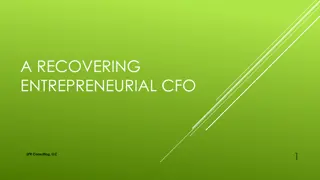Exploring Entrepreneurial Activities in Extra-curricular Enterprise Programs at Plymouth University
Investigate the impact of extra-curricular enterprise activities on entrepreneurial capabilities, behaviors, and competencies, featuring insights from Dr. Emily Beaumont, Sarah Preedy, and Sarah Stevenson. The study delves into the development workshops and events like Social BETA Enterprise, FLUX Talent Storm, and Hackathon, examining the skills acquired, expectations, and engagement levels among participants. Various aspects such as opportunity alertness, resilience, leadership, and risk-taking propensity are explored to better understand the entrepreneurial journey in the academic setting.
Download Presentation

Please find below an Image/Link to download the presentation.
The content on the website is provided AS IS for your information and personal use only. It may not be sold, licensed, or shared on other websites without obtaining consent from the author. Download presentation by click this link. If you encounter any issues during the download, it is possible that the publisher has removed the file from their server.
E N D
Presentation Transcript
Extra-curricular enterprise activities-exploring the missing perspective Dr Emily Beaumont, Sarah Preedy and Sarah Stevenson Plymouth University 1 1 of 20
2 of 20
Extra-curricular Enterprise Activities Development Workshops Social BETA Enterprise FLUX Talent Storm Hackathon 3 of 20
What is my entrepreneurial capability? 4 of 20
5 of 20
What extra-curricular enterprise activity did you just engage in? What behaviours and competencies do you think you developed through this activity? 6 of 20
Alertness to opportunities Opportunity exploitation Interpersonal Skills Self-efficacy Effectual Reasoning Resilience Any others (please state) Networking Perseverance Creativity Leadership Increase in confidence Tolerance of Ambiguity Locus of control Propensity to take risks 7 of 20
Business Science and Engineering Arts and Humanities HHS and PUPSMED Enterprise Engagement (Pre) Non-Engagement (Post) 4% 3% 9% 3% 6% 3% Male Female Unknown/Ot her 2% 36% Non-Engagement (Pre) 27 (37.5%) 44 (61.1%) 1 (1.4%) Non-Engagement (Post) 14 (45.2%) 16 (51.6%) 1 (3.2%) 52% 82% Enterprise Engagement (Pre) Non-Engagement (Pre) Enterprise Engagement (Pre) 48 (40.3%) 70 (58.8%) 1 (0.8%) 17% 3% 17% Enterprise Engagement (Post) 18 (30.5%) 32 (54.2%) 9 (15.3%) 3% 3% 36% 5% 2% 73% 41% 8 of 20
Expectations of Extra-curricular Enterprise Activities Number of Respondents Category Examples information around enterprise/community projects , to better my understanding of sustainable business , a better understanding of social enterprises Sustainability, social enterprise or community- focussed expectation 26 An expectation of primarily enjoyment networking or socializing 9 fun , it would be funny to gain insight on how to do better presentations , develop insight to business world and life as an entrepreneur An aim of gaining career or business skills 24 An expectation related to generalized skills or positive experiences 47 knowledge , positive way of thinking , self-development possibly frustration, but hopefully a pleasant surprise , open-minded- I ll find out No defined aim, or a negative expectation 4 A primarily study-related expectation 0 N/A 9 of 20
Expectations of extra-curricular activities (Non-enterprise) Socializing, networking (e.g. a wider social network of friends , building more networks , friends/ wider social life , spending time with like-minded people ) Enjoyment and life skills (e.g. fun , personal development , laughs , discipline ) Health (e.g. increased fitness , healthy life , relieve stress and keep fit and healthy ) Career and business skills (e.g. get some idea about opportunities after studies , additions to my CV and further experience and skills , qualifications in certificate form ) Studies (e.g. Network to gain further knowledge. Also like- minded people who may help with my own degree ) Other (e.g. a spiritual or niche interest benefit, such as becoming more involved in a religion or improving at skiing) 10 of 20
71.9% 62.1% 62.1% 60.9% 56.3% 51.7% 51.7% 46.9% 46.4% 44.8% 44.8% 37.9% 37.9% 36.6% 34.8% 33.9% 33.9% 32.8% 20.7% 20.7% Effectual Reasoning Networking Leadership Creativity Self-Efficacy EntEng(Pre) EntEng(Post) NonEng(Pre) NonEng(Post) 11 of 20
70.3% 62.1% 62.1% 54.7% 51.7% 51.7% 44.8% 44.8% 43.8% 35.7% 35.9% 34.8% 34.5% 34.5% 29.7% 27.6% 27.6% 12.5% 7.1% 6.3% Interpersonal Skills Resilience Locus of Control Tolerance of Ambiguity Alertness to Opportunities EntEng(Pre) EntEng(Post) NonEng(Pre) NonEng(Post) 12 of 20
85.9% 58.6% 58.6% 58.6% 58.6% 53.1% 51.6% 42.2% 41.4% 41.4% 34.5% 34.5% 32.1% 29.5% 24.1% 24.1% 17.0% 13.4% 12.5% 3.6% Opportunity Exploitation Increased Confidence Perseverance Risk-Taking Other EntEng(Pre) EntEng(Post) NonEng(Pre) NonEng(Post) 13 of 20
Non-Enterprise extra-curricular engaged students 14 of 20
Extra-curricular Enterprise Activity engaged students 15 of 20
Preliminary Conclusions 16 of 20
Further Research 17 of 20
Implications for Practice 18 of 20
Extra-Curricular Enterprise Activity Workshop Day Friday 21st October 2016 At Plymouth University For more information speak or email me at emily.beaumont@plymouth.ac.uk 19 of 20
Key References Abreu, M. and Grinevich, V. (2013), The nature of academic entrepreneurship in the UK: Widening the focus on entrepreneurial activities , Research Policy, Vol. 42,No. 2, pp. 408 422. http://sephe.eu/fileadmin/sephe/documents/sephe_final-report_2015-06-30_v1.10.pdf Bechard, J-P. and Gregoire, D. (2005), Entrepreneurship education research revisited: the case of higher education , Academy of Learning and Education, Vol. 4, No. 1, pp. 22 43. BIS. (2014), British Invention : Global impact. The government s response to Sir Andrew Witty s Review of Universities and Growth. BIS : London. https://www.gov.uk/government/uploads/system/uploads/attachment_data/file/291938/bis-14-540-government-response-witty-review-british-invention-global-impact.pdf Bygrave, W. D., & Hofer, C. W. (1991) Theorizing about entrepreneurship, Entrepreneurship Theory and Practice, vol. 16, 2, pp. 13-22 Colette, H. (2013) Entrepreneurship education in HE : are policy makers expecting too much? , Education + Training, vol. 55, 8, pp. 836-848 European Commission (2007) ey competences for lifelong learning ,European Reference Framework. European Commission. Accessed March 7 2016. Available at: [http:// europa. eu/ legislation_ summaries/ education_ training_ youth/ lifelong_ learning/ c11090_ en. htm.] Gedeon, S.A. (2014) Application of best practices in university entrepreneurship education , European Journal of Training and Development, vol. 38, 3, pp. 231-253 Georgiadis, P. And Kakouris, A. (2016) Analyzing entrepreneurship education: a bibliometric survey pattern , Journal of Global Entrepreneurship Research, vol. 6, 6 Gibb, A.A. (2010), Towards the entrepreneurial university , NCEE, Coventry. http://eulp.co.uk/wp-content/uploads/2013/11/towards_the_entrepreneurial_University.pdf Hannon, P. (2007), Enterprise for all? The fragility of enterprise provision across England s HEIs , Journal of Small Business and Enterprise Development, Vol. 14, No. 2, pp. 183 210. Jones, C. and Matlay, H. (2011), Understanding the heterogeneity of entrepreneurship education: going beyond Gartner , Education and Training, Vol. 53 No. 8/9, pp. 692 703. Kuratko, D. (2005), The Emergence of Entrepreneurship Education: Development, Trends, and Challenges , Entrepreneurship Theory and Practice, Vol. 29, No. 5, pp. 577 598 Lilischkis, S., Volkmann, C., and Halbfas, B. (2015), Supporting the Entrepreneurial Potential of Higher Education: Final Report . European Commission: Brussels. McMullen, J.S. and Shepherd, D.A., (2006) Entrepreneurial Action and the Role of Uncertainty in the Theory of the Entrepreneur , Academy of Management Review, vol 31, pp.132 152 Morris, M. H., Kuratko, D. F., Schindehutte, M. and Spivack, A. J. (2012) Framing the Entrepreneurial Experience. Entrepreneurship Theory and Practice, vol. 36,pp. 11 40 Morris, M. H., Webb, J. Fu, J. And Singhal, S. (2013) A Competency-Based Perspective on Entrepreneurship Education: Conceptual and Empirical Insights, Journal of Small Business Management, vol. 51, 3, pp. 352-369 Neck, H. M., Greene, P. G. and Brush, C. G. (2014). Teaching entrepreneurship: A practice based approach. Edward Elgar Publishing, UK. Penaluna, K. Penaluna, A. and Jones, C. (2012), The context of enterprise education: insights into current practices , Industry and Higher Education, Vol. 26, No. 3, pp. 163 175. Pittaway, L. and Edwards, C. (2012), Assessment: examining practice in entrepreneurship education , Education and Training, Vol. 54, Iss. 8/9, pp. 778 800. QAA (2010) Code of Practice Section 8: Career Education, Information, Advice and Guidance, Accessed March 18 2016. Available at: [http://www.qaa.ac.uk/academicinfrastructure/codeofpractice/section8/default.asp.] Rae, D. (2010) Universities and enterprise education: responding to the challenges of the new era, Journal of Small Business and Enterprise Development, vol. 17, 4, pp 591-606 Rae, D. Martin, L. Antcliff, V. and Hannon, P. (2012), Enterprise and entrepreneurship in English Higher Education : 2010 and beyond , Journal of small business and enterprise development Vol. 19. No. 3. pp 380 401. Sewell, P. and Pool, L. (2010), Moving from conceptual ambiguity to operational clarity , Education and Training, Vol. 52, No. 1, pp. 89 94. Sodexo, (2014) The Sodexo University Lifestyle Survey 2012, Sodexo and the Times Higher Education. Accessed March 21 2016. Available at: [http://digitalpages.digitalissue.co.uk/?userpath=00000082/00008121/00074929/] Tymon, A. (2011). The student perspective on employability. Studies in Higher Education, iFirst Article, 1-16. Universities UK. (2013) Universities UK response to the Witty Review. Universities UK : London. http://www.universitiesuk.ac.uk/highereducation/Documents/2013/UUKresponseToTheWittyReview.pdf Wadhwa, V., Krisztina, H., Aggarwal, R., and Salkeverm A., (2009) Anatomy of an Entrepreneur: Family Background and Motivation , Kauffman Foundation Small Research Projects. Accessed March 232016. Available at: [http://ssrn.com/abstract=1431263]or [http://dx.doi.org/10.2139/ssrn.1431263] 20 of 20



